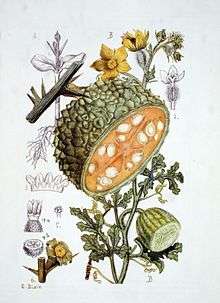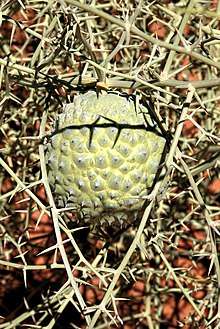Acanthosicyos horridus
Acanthosicyos horridus is an unusual melon that occurs in Namibia, South Africa, Angola and elsewhere; in English it is known as butter-nuts or butterpips,[3] in one of the Khoisan languages it is locally called ǃnaras or ǃnara (! is pronounced with a click, somewhat like the "tsk" when English people are tutting, tsk-tsk-tsk).[3][4][5]
| Acanthosicyos horridus | |
|---|---|
| Scientific classification | |
| Kingdom: | Plantae |
| Clade: | Tracheophytes |
| Clade: | Angiosperms |
| Clade: | Eudicots |
| Clade: | Rosids |
| Order: | Cucurbitales |
| Family: | Cucurbitaceae |
| Genus: | Acanthosicyos |
| Species: | A. horridus |
| Binomial name | |
| Acanthosicyos horridus | |

Ecology
It is a dioecious plant found in sand desert but not stony plains, in areas with access to ground water such as ephemeral rivers and paleochannels, where sand accumulating in the shelter of its stems can form hummocks up to 1000–1500 m2 in area and 4 meters in height. Its stems may rise more than a meter above the hummocks, while its system of thick taproots can extend up to 50 m downward.[4] The plant is leafless, so modified stems and spines 2–3 centimetres long serve as the photosynthetic "organs" of the plant.[5][6] The plant can survive many years without water.[4]
Acanthosicyos horridus typically occurs in the absence of other vegetation due to the harshness of the climate,[4] though Eragrostis spinosa and Stipagrostis sabulicola grasses may grow between its hummocks. It is regarded as a keystone species because its melons, seeds, shoots, and flowers are food sources for beetles, gemsbok, and ostrich, while small rodents such as Rhabdomys pumilio, Desmodillus auricularis, and Thallomys nigricauda take shelter amid the spiny tangle of its stems.[6] The katydid Acanthoproctus diadematus feeds on the plant, moving between different bushes at night.[7]
Uses

The melon fruits average 1 kg and are pale green and spiny. Within it has a sweet, aromatic, watery, yellow-orange pulp. The large edible seeds, white to cream in color, are known as butter-nuts or butterpips. These have been exported for use in baked goods.[3][4]
The fruit serves as a food source for Nama people from February to April and August to September.[5]
References
- "Acanthosicyos horridus". International Plant Names Index (IPNI). Royal Botanic Gardens, Kew.
- Bentham, G. & Hooker, J.D. (1867) Gen. Pl. 1(3): 824
- Grubben, G.J.H. & Denton, O.A. (2004) Plant Resources of Tropical Africa 2. Vegetables. PROTA Foundation, Wageningen; Backhuys, Leiden; CTA, Wageningen.
- "Indigenous plants of Namibia: !nara". Travel News Namibia. 2015-03-24. Archived from the original on 2017-11-04. Retrieved 2017-11-05.
- "Nara Plant, Acanthosicyos horrida, Namibia". Siyabona Africa, Kruger Park Safaris. Archived from the original on 9 June 2011. Retrieved 2011-06-23.
- Cornelia Bettina Krug (2002). "Adaptations of the four-striped field mouse (Rhabdomys pumilio, Sparman 1784) to the Namib Desert" (PDF). University of Bonn.
- Conti, E.; Viglianisi, F.M. (2005). "Ecology of the calling song of two Namibian armoured ground crickets, Acanthoplus longipes and Acanthoproctus diadematus (Orthoptera Tettigoniidae Hetrodinae)". Ethology Ecology & Evolution. 17 (3): 261–269. doi:10.1080/08927014.2005.9522596. Archived from the original on 2011-07-22. Retrieved 2009-09-18.
External links
- PROTAbase on Acanthosicyos horridus
- Dressler, S.; Schmidt, M. & Zizka, G. (2014). "Acanthosicyos horridus". African plants – a Photo Guide. Frankfurt/Main: Forschungsinstitut Senckenberg.
| Wikimedia Commons has media related to Acanthosicyos horridus. |